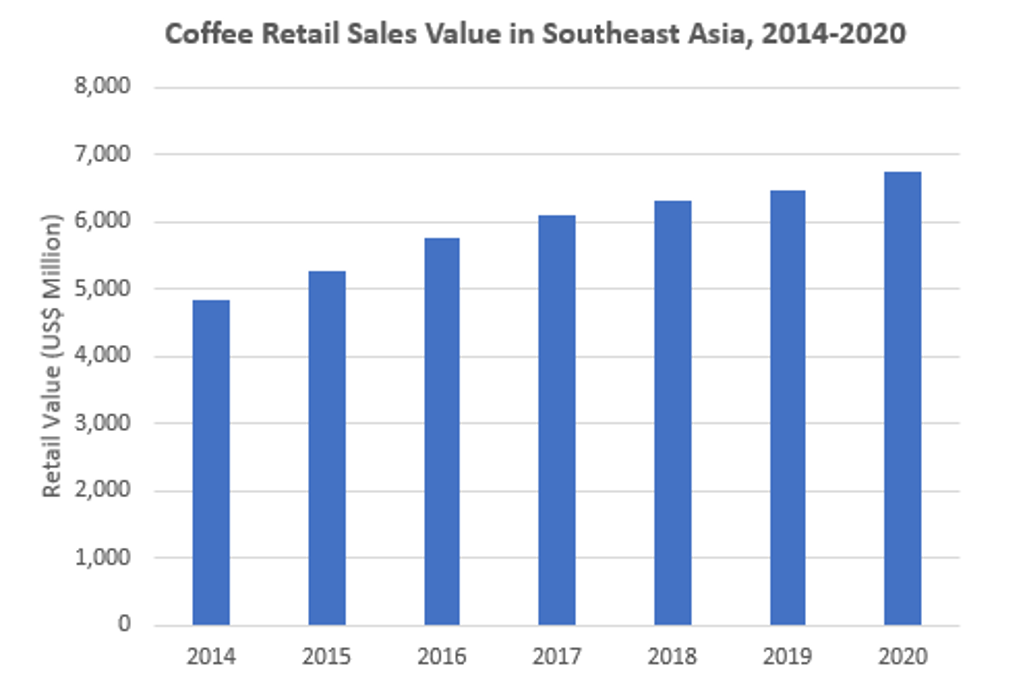Southeast Asia is one of the fastest-growing regions for coffee globally. According to Euromonitor International, retail sales of coffee in the six biggest Southeast Asian economies—Indonesia, Malaysia, the Philippines, Singapore, Thailand and Vietnam—reached USD6.5 billion in 2019, a 6% compound annual growth rate between 2014-2019, compared to a global average of 5% over the same period. The region consumed an estimated 1.2 million tonnes of coffee through retail and foodservice channels in 2019.
In 2020, countries across Southeast Asia implemented various social distancing and lockdown measures to curb the spread of Coronavirus (COVID-19). Inevitably, economic growth in Southeast Asian economies has been impacted, albeit to varying degrees. The lockdown measures affected foodservice operations, which changed consumption behaviours and distribution as a result. In 2020, sales of coffee through foodservice declined drastically, whereas retail coffee sales continued to grow, benefiting from the shift to at-home consumption. Particularly, Singapore, Thailand, and Vietnam saw faster retail coffee sales growth in 2020 compared to 2019.
Source: Euromonitor International. Note: Includes sales from Indonesia, Malaysia, the Philippines, Singapore, Thailand, and Vietnam only
Foodservice sees significant declines, while retail remains resilient
Social distancing measures and temporary business closures significantly affected foodservice sales due to decreased on-the-go and dine-in occasions. The greater availability of food delivery services in the region, such as Grab, Foodpanda and GoFood, have softened the impact; however, the increase in food delivery sales is unlikely to offset lost dine-in sales. Coffee sales via foodservice have not been spared either. Overall, coffee foodservice volume sales in Southeast Asia saw a decline of 20% in 2020 compared to 2019, according to Euromonitor International.
Meanwhile, retail coffee sales, which comprise more than 80% of total coffee volume sales in the region, remain relatively resilient, with 3% growth in 2020, according to Euromonitor International. Limitations on foodservice outlet operations as well as work-from-home policies resulted in a shift from foodservice and institutional to at-home consumption. In 2020, the “Dalgona coffee” trend also contributed to some increase in at-home consumption in the region. This new coffee preparation method involves whipping coffee to make a foamy drink. Many people who found the resulting beverage texture and look interesting tried to emulate this trend during their free time at home. In Thailand, brew-your-own coffee kits boomed, as consumers had more time to spend on preparing coffee while working from home. In Singapore, the coffee pods category saw strong retail sales growth in 2020, as the product appealed to consumers with sophisticated tastes who are now spending most of their time working or studying remotely.
Affordability is another factor driving a relatively good performance of retail coffee sales. Retail sales in the region are dominated by instant coffee mixes, which are cheap and widely available. As disposable income declines, many consumers are down trading to economical products, such as instant coffee mixes.
E-commerce shows growth potential
The importance of e-commerce cannot be discounted in 2020. Despite strong overall growth in Southeast Asia between 2014-2019, the adoption of e-commerce for grocery products, particularly food and beverages, remained quite low during this period. Many consumers still found it more convenient to shop for groceries in physical retail stores, and the relatively high delivery cost or minimum order spend for free delivery discouraged some consumers from purchasing groceries via e-commerce.
Due to COVID-19, many consumers embraced shopping online for groceries due to safety concerns. In 2020, in these six Southeast Asian markets, overall e-commerce grew by 53%, while food and beverages e-commerce is estimated to have grown by 96%. While leading coffee players in the region had an established presence on e-commerce platforms, in 2020, many smaller businesses also came online after sales from physical outlets saw a decline. In Indonesia, for example, Tokopedia, one of the leading e-commerce marketplaces in the country, held a campaign called #SatuDalamKopi to promote local coffee brands, including independent cafés, which diversified to sell products online after traffic to physical outlets declined during the implementation of large-scale social distancing measures. Grab-and-go coffee players and independent cafés in Indonesia also started selling ready-to-drink coffee in 500ml or 1-litre bottles via e-commerce platforms. This larger pack size allows consumers to purchase at a slightly cheaper unit price for consumption over a few days, offering more value for money compared to single-portion drinks for immediate consumption.
Looking ahead, improvements in foodservice consumption are expected in 2021, although recovery to 2019 levels will be gradual over the next five years due to lingering social distancing measures and lower disposable incomes. The adoption of food delivery, which accelerated in 2020, is also expected to continue to grow. Meanwhile, retail sales are likely to see stable growth, with e-commerce expected to be one of the fastest-growing distribution channels through 2025, as more players enter the space and provide a greater variety of products, and consumers get used to the convenience of shopping for groceries online.

